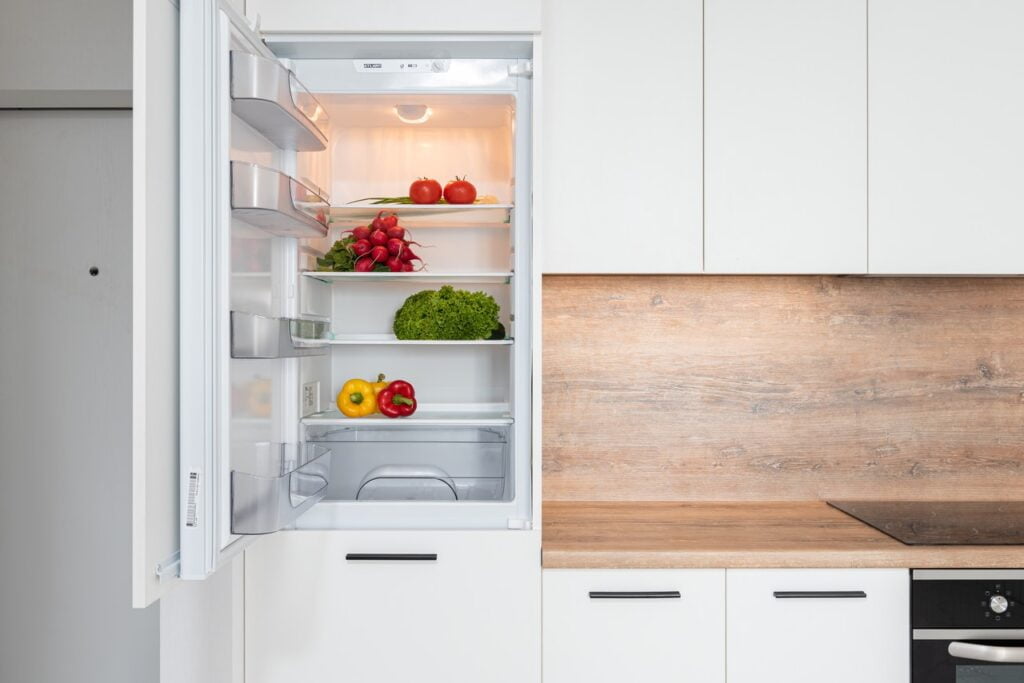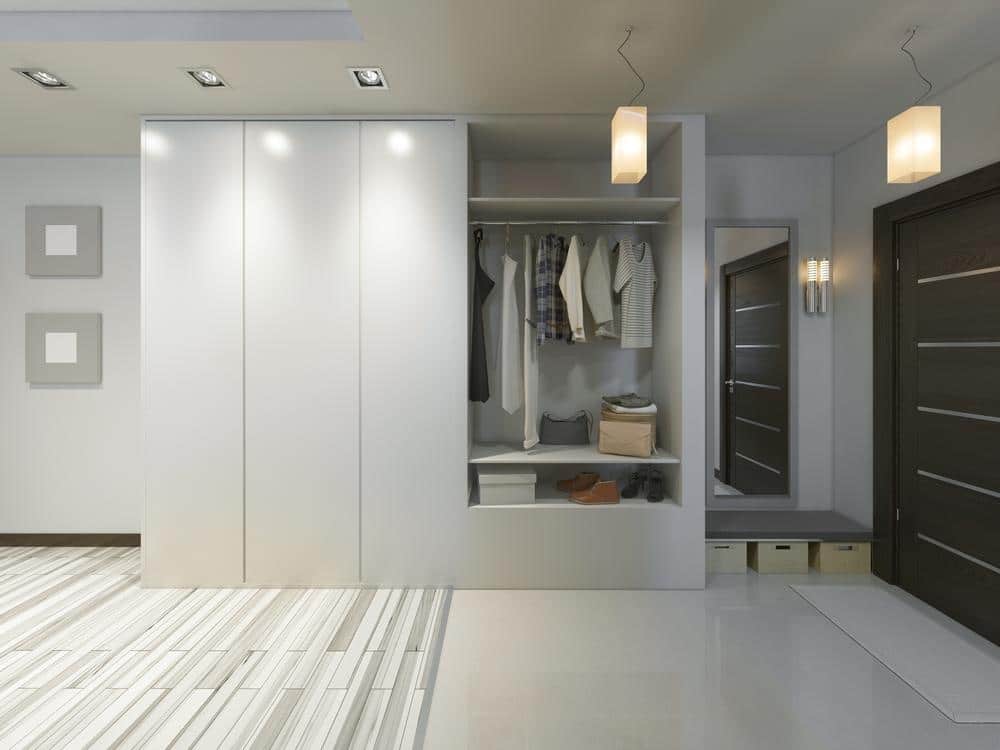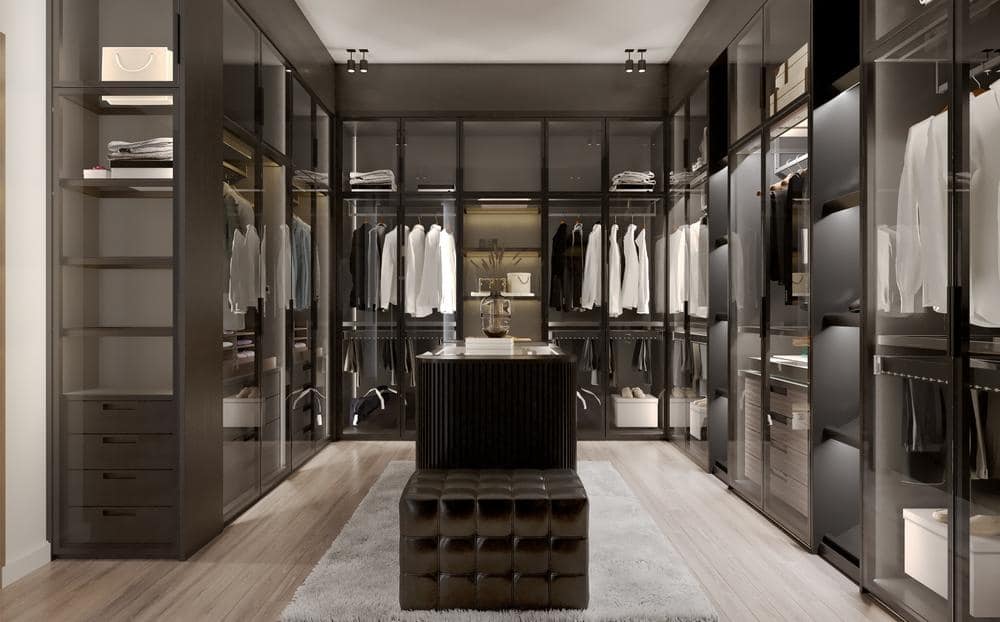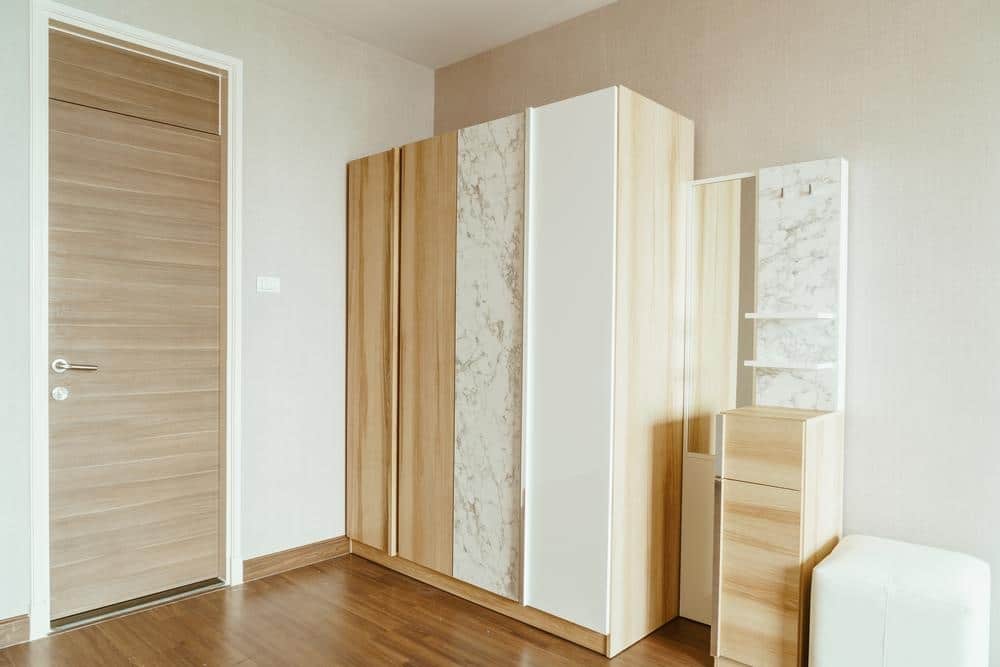You want to add cabinets for storage to your kitchen but have a limited amount of space. You’re curious about how narrow or small a kitchen cabinet can be. There are various types of kitchen cabinets available, as well as some useful space-saving techniques. This post will provide you with all of the information you need about narrow kitchen cabinets and other ways to save space in your kitchen. Continue reading to find out more.
Kitchen cabinets can be as little as nine inches wide. This is frequently used as a spice rack or to store cookie sheet pans. Cabinets are typically manufactured in increments of 36 inches wide. The depth of the cabinet can range from 12 to 24 inches, and the height can range from 12 to 42 inches.

You probably want more ideas for designing your space now that you know the most common and narrowest available kitchen cabinet sizes. Narrow kitchen cabinets can serve various functions, but you can customize your cabinetry to fit your lifestyle. This post will give you some ideas for organizing deep, narrow cabinets and what to do with the space between a cabinet and a refrigerator. Continue reading to get all of the answers to your questions.
The Trend of Narrow Kitchen Cabinets
Table of Contents
- The Trend of Narrow Kitchen Cabinets
- How Narrow Can A Kitchen Cabinet Be?
- Kitchen Wall Cabinet Height, Depth and Width
- Kitchen Tall Cabinet Height, Depth, and Width
- How Narrow Can A Pantry Be?
- What Sizes Do Kitchen Cabinets Come In?
- Base Cabinet Sizes
- Wall or Upper Kitchen Cabinet Sizes
- How to Determine the Height of Your Wall Cabinets
- How Do You Organize Deep Narrow Kitchen Cabinets?
- How Much Space Between Kitchen Cabinets And Appliances?
- What Do You Do With Space Between Kitchen Cabinets And Fridge?
- How Should I Coordinate Kitchen Cabinet Colors?
- Conclusion
- What is the most acceptable width of kitchen cabinet in a house?
- Do they make narrow kitchen cabinets?
- Does cabinet depth include doors?
- What is the narrowest cabinet size?
- What is the minimum width of a kitchen cabinet?
- How narrow can a kitchen be?
- What do you put in narrow kitchen cabinets?
- What is the narrowest kitchen cabinet?
- What is a narrow kitchen cabinet width?
- What is the smallest width base cabinet?
- What is a good layout for narrow kitchens?
- What is a narrow kitchen called?
- What is the Smallest Width of Kitchen Cabinets?
- What is the Narrowest Depth Kitchen Cabinet?
- How Shallow Can Kitchen Cabinets Be?
- What is the Most Acceptable Width of Kitchen Cabinet?
- What is the Minimum Width of a Kitchen?
- Can You Get Narrow Depth Kitchen Units?
- How Deep Are Ikea Kitchen Cabinets?
- Can You Get Base Cabinets Less Than 24 Inches Deep?

As time progresses, more and more small homes are being built, creating a need for new kitchen cabinet types to accommodate the small spaces. Narrow kitchen cabinets are an ideal solution; they provide substantial storage in small spaces while still maintaining stylishness. These smaller cabinets save space and increase the options of where they can be placed around the kitchen, providing greater flexibility when decorating.
The sleek design of narrow kitchen cabinets makes them a great addition to any small home or apartment, and they can easily be integrated into existing kitchens or used as part of a new kitchen completely.
How Narrow Can A Kitchen Cabinet Be?
Kitchen cabinets are available in various width, height, and depth measurements. The narrowest kitchen cabinet is nine inches wide, and it is frequently used as a pull-out spice rack.
It is an excellent way to make use of small spaces that a standard-sized cabinet would not be able to fill. These narrow cabinets can also be used to store long utensils that would otherwise be too long to fit in drawers, as well as cookie baking sheets.
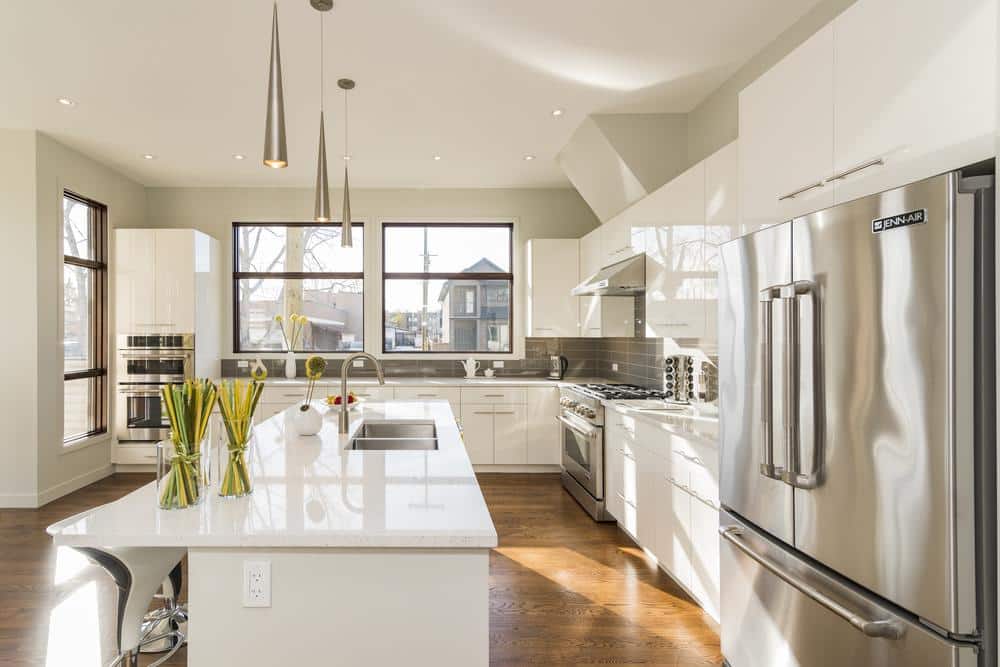
What Is The Smallest Depth Of A Kitchen Cabinet?
The depth of a kitchen cabinet can be as little as 12 inches. The standard depth of kitchen cabinets is 24 inches or two feet. With a standard 25-inch depth countertop, allowing for a one-inch overhang.
This also corresponds to the standard depths of ovens and dishwashers. As a result, most people will not have a use for a shallower depth base cabinet in the kitchen. Upper cabinets are typically 12 inches deep, providing ample counter space without hitting your head on the cabinet.
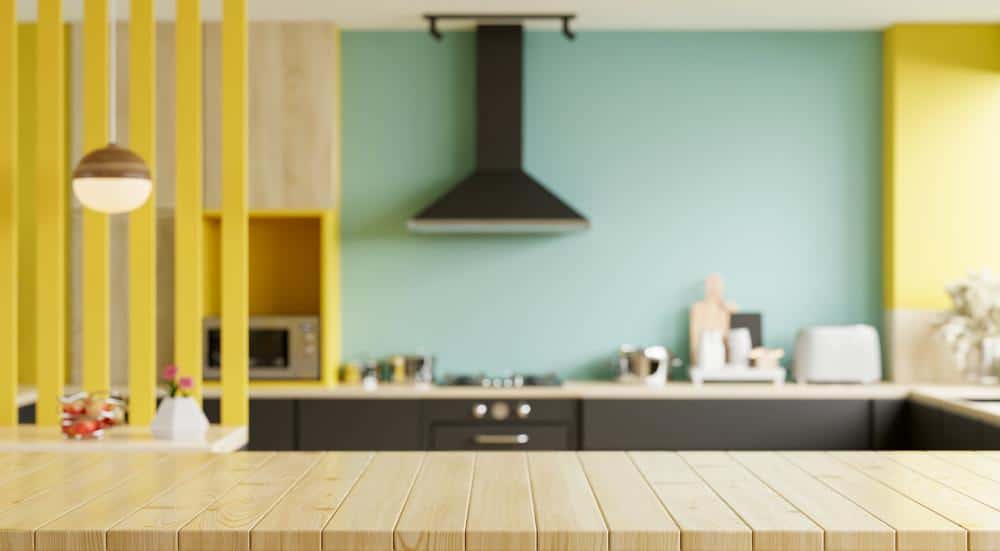
What Is The Shortest Height Of A Kitchen Cabinet?
A kitchen base cabinet is 34.5 inches tall. A standard countertop will raise the height to 36 inches, the same as a standard stove. If a different height is required, cabinets will have to be made to order.
Countertops are typically 36 inches high with 18 inches of backsplash before the upper cabinets begin. The size of the upper cabinets is determined by the amount of space available from the top to the backsplash and all the way up to the ceiling.
Kitchen Wall Cabinet Height, Depth and Width
Wall cabinets are used to store food and lightweight kitchen equipment. They are attached to the studs with screws. Cabinets may be mounted to the ceiling or overhanging soffits in some installations, such as a bank of upper cabinets above a peninsula or island. Wall cabinets are the most visible cabinet in a kitchen and are used the most.

Wall cabinets are usually limited to 12, 36, and 42 inches because countertops and ceilings must be balanced. Most standard kitchens contain wall cabinets that are 30 or 36 inches tall, with the soffits rising up above them. Wall cabinets in these kitchens are typically 12 or 15 inches high. A 30-inch wall cabinet is good for housing a refrigerator. A 15-inch wall cabinet is just enough for a fridge and can rest against the kitchen ceiling. If a wall cabinet extends all the way to the ceiling, a 48-inch cabinet is likely the most suitable choice.
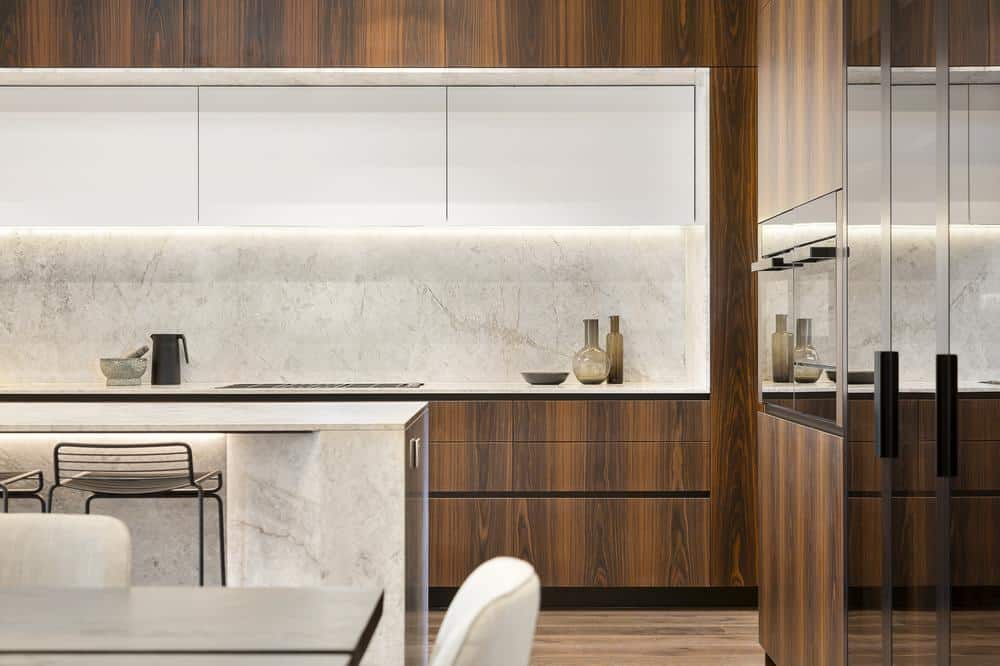
Wall cabinets are typically deeper than base cabinets, and shallower cabinets are more frequent to maximize countertop space. Base cabinets are typically 12 inches deep, but deeper cabinets are more practical if you want to maximize the countertop workspace below the kitchen cabinets. Shallow cabinets are safer to connect to the wall. Because of the compromise between storage space and workable countertop area, 12-inch deep wall cabinets are quite common. Microwave ovens are frequently placed above 15- to 18-inch deep cupboards.
Wall cabinets come in widths of 9 to 48 inches in three-inch increments, but they are rare to be wider than 36 inches. The most common cabinet dimension is 30 inches, which provides the best storage proportions.

Kitchen Tall Cabinet Height, Depth, and Width
In addition to standard cabinets, many kitchens have extra-tall cabinets in alcoves next to the refrigerator. These cabinets are sometimes referred to as pantry cabinets or utility cabinets because they’re tall enough to extend from floor to ceiling. Kitchen cabinets often have a tall, capacious appearance, making them suitable for storing large amounts of food.
Kitchen cabinets of 84 or 96 inches are the most typical ones. In a standard 8-foot room, a 96-inch cabinet covers the floor to the ceiling, but an 84-inch cabinet provides a foot of breathing room and matches the surrounding wall cabinets uniformly.
Tall cabinets are frequently available in 12-inch or 24-inch depths. Pantry cabinets that use the 12-inch depth are typically available, while utility cabinets with a 24-inch depth are excellent for brooms, mops, and other cleaning appliances. A pull-out and slide hardware scheme may increase the functionality of 24-inch-deep cabinets.
How Narrow Can A Pantry Be?
A walk-in pantry should have at least a 36-inch-wide walking space. This is also the standard size of a door. You will have difficulty walking into and unloading heavy groceries if the pantry is too narrow. Ideally, there will be enough shelving on two sides to prevent you from placing items on the pantry floor.
Pantry cabinets can be as narrow as any other kitchen cabinet, down to nine inches. This is great for small kitchens because it adds a lot of extra storage space for food or dishes. A typical pantry cabinet is about six feet tall and has enough space for at least four 15-inch-high shelves.
What Sizes Do Kitchen Cabinets Come In?
Upper kitchen cabinets are typically 12 inches deep but can be as deep as 18 inches. The height varies depending on the size of your space, your kitchen’s design, and your ceiling’s height. They can range in height from 12 to 42 inches, with three to five-inch increments in between. Kitchen cabinet widths range from nine inches to 48 inches.
Standard base cabinets are designed to be the same height and depth as the oven and dishwasher appliances. Because cabinets are 34.5 inches tall, the countertop is usually 36 inches off the ground. A base cabinet has a depth of 24 inches. Base cabinets will range in width from nine to 48 inches.
Base Cabinet Sizes
The height of base cabinets is often 34.5 inches without a countertop and 36 inches with a countertop. The height of the toe kick portion, the bottom portion of the cabinet that sits on the floor, is 4.5 inches. Various styles are available for base cabinets, such as single doors, double doors, drawers, or a combination of a drawer and doors. You may mix and match the sizes and styles to get your ideal base cabinet.
Wall or Upper Kitchen Cabinet Sizes
Since wall cabinets don’t have a countertop, they have to be mounted properly on the walls to hold the weight of plates and glasses. Wall cabinets come in a variety of sizes. Common sizes for wall cabinets are 30, 36, and 42 inches. The width of wall cabinets will be 84, 90, and 96 inches when mounted on your base cabinets.
The space between your base and wall cabinets is 18 inches (after the countertops). That’s a little space, but remember that wall cabinets are not as deep as base cabinets, so there are a lot of overhangs. Even though standard kitchen cabinet depths range from 12 to 24 inches, some wall cabinets can be as deep as 24 inches. Wall cabinets installed over a refrigerator will be deeper to ensure the front portion of the cabinet lines up with the front of the appliance.
How to Determine the Height of Your Wall Cabinets
To determine the right measurement for your wall cabinets, first, measure the height of your ceiling. For example, when you want to use 30” wall cabinets, your ceiling height must be eight feet. If you want your cabinets to reach the ceiling, you will install 42” cabinets. If crown molding is around the ceiling, leave space for it. You would likely use 36” cabinetry for an eight-foot ceiling with crown molding. The blank space between the molding and the cabinets is avoided by using 42” cabinets. 36” cabinets may be the best option for those with taller ceilings.
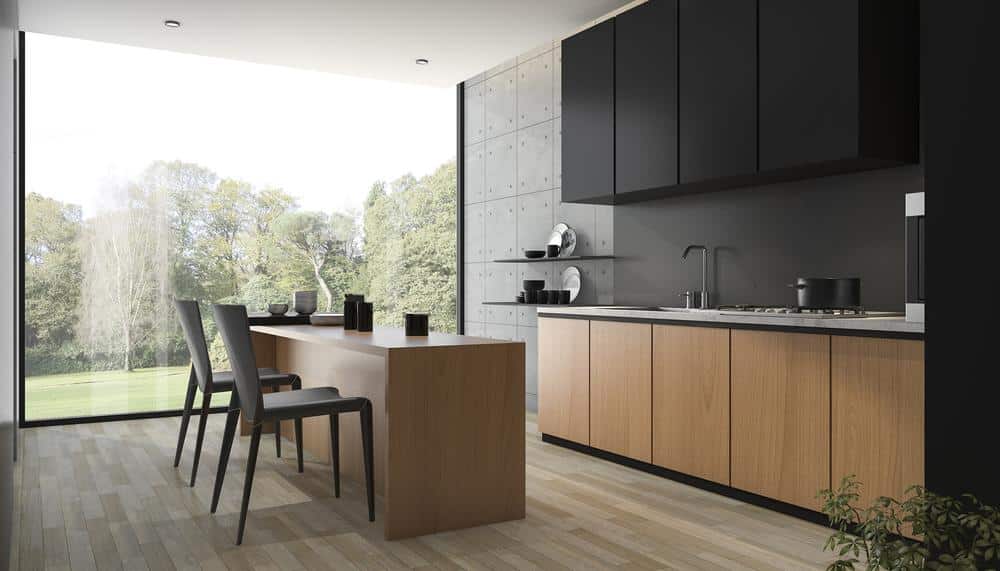
How Do You Organize Deep Narrow Kitchen Cabinets?
Deep kitchen cabinets have a lot of storage space, but they need to be organized properly to meet your needs. The first step is to label each shelf or section of a shelf with a category.
Anything you don’t want your children to have easy access to should be kept on higher shelves. Anything you frequently use can be placed between your eye and hand level for easy access.
Use baskets to group together similar types of food and clearly label them. Place new food in the back and older food in the front so you can use it before it expires.
If you have family members who frequently use the same items, you could even put them in the same basket. When more people use a pantry, it is more likely that items will be moved around and become disorganized over time.

How Much Space Between Kitchen Cabinets And Appliances?
It is necessary to leave a small amount of space around the refrigerator for ventilation. The recommended amount varies depending on the manufacturer. Whirlpool recommends leaving a quarter-inch gap on the refrigerator’s sides, back, and top for ventilation.
Samsung recommends leaving 50 millimeters (about two inches) on all sides, including the back. Samsung recommends leaving 100 millimeters (about 4 inches) of space on top for ventilation.
The stove and dishwasher can be placed right next to each other, with no space between them. Allow at least 24 inches of space between the top of your stove and the bottom of the upper cabinet for safety reasons.
What Do You Do With Space Between Kitchen Cabinets And Fridge?
If you only have a narrow crack between the fridge and the cabinets on each side, you can use a gap filler to fill in the gaps. These bridge the gap between cabinets, counters, and appliances like the oven or refrigerators. A trim kit can also be used to fill in the gap around the fridge.
If you have some extra space on the top of your fridge, consider installing a wine rack, a small shelf, or a panel that matches the color of your cabinetry . It is up to you whether you want the space to be functional or if you prefer a clean, seamless look in your kitchen. Trim kits or gap fillers should be used to fill small gaps.

How Should I Coordinate Kitchen Cabinet Colors?
When designing your kitchen, you may have to coordinate various colors. The knobs and handles on your kitchen cabinets should be similar but not identical in color to your appliances.
Keep this in mind when selecting kitchen appliances and cabinet hardware.
You can match the color of your kitchen walls to your cabinets. This is not required because contrasting colors can be appealing at times.
Before making a decision on a color scheme for your kitchen, you should look at several examples. If done correctly, contrasting light and dark with the cabinets, floors, walls, and appliances can result in an elegant kitchen.
Conclusion
Kitchen cabinets can be as small as nine inches wide. This type of cabinet is ideal for storing flat cookware, cookie sheets, and a slide-out spice rack. Cabinets can be up to 48 inches wide. They can range in height from 12 to 42 inches. Kitchen cabinets are typically 24 inches deep for base cabinets and 12 inches for upper cabinets. Numerous cabinets are available on the market to meet your specific design requirements.
What is the most acceptable width of kitchen cabinet in a house?
The most common width we do is 24 inches, which could either have one door or two 12-inch doors. We also install 36″ wide cabinets; these work well if you’re looking for a spacious pantry without taking up too much space in your kitchen!
Do they make narrow kitchen cabinets?
Kitchen cabinets come in all shapes and sizes. Cabinets can be as narrow as nine inches, commonly used for storing spice racks or cookie sheet pans; they’re also often 36-wide with depths that range from 12 – 24 studs (or 12+ centimeters) tall! You’ll find heights between 42-80″, depending on what you need them to store–the perfect height is determined by your needs.
Does cabinet depth include doors?
When you’re installing a kitchen cabinet, it’s important to know the depths of your cabinets. These numbers will help determine if there is enough space for all of them and what kind (or style) would best suit your needs!
What is the narrowest cabinet size?
The 9-inch cabinet is the narrowest option for kitchen cabinets, aside from a wall filler of 3 inches or a base filler measuring 6 inches in width and 34.5 inches in height.
What is the minimum width of a kitchen cabinet?
The standard minimum width for a kitchen cabinet is 15 inches, although this may vary depending on the style and configuration of your cabinets. Generally speaking, if you are installing base or wall cabinets, they should be at least 12 inches deep in order to accommodate most standard plate sizes. Additionally, pantry or tall cabinet depths typically have a range from 24 to 36 inches.
How narrow can a kitchen be?
A minimum of 3 feet between countertops is ideal for single-user kitchens. For optimal results, however, four to five feet of walking space should be reserved.
What do you put in narrow kitchen cabinets?
Narrow kitchen cabinets can be great for storing various items, such as dishes, Tupperware, and cooking tools. The key to making the best use of your limited space is to maximize vertical storage by stacking items or using drawers or shelves that can squeeze into narrow spaces. Here are some storage tips for narrow kitchen cabinets:
- Hang pots & pans – Instead of storing bulky pots and pans in the bottom of a cabinet, hang them from a pot rack. This saves precious floor space and keeps your cookware within reach when needed.
- Use baskets & stackable trays – Baskets provide an attractive way to store items within easy reach without fully exposing them on open shelving. Stackable trays also work well in narrower cabinets because they minimize wasted vertical space while allowing you to access what’s stored inside each tray layer easily.
- Lazy Susans & tiered organizers – If you have short-but-wide closet spaces with limited shelf height, opt for lazy Susans (spinning racks) with multiple tiers that let you store more in the same amount of real estate than traditional flat shelving units do alone. Tiered organizers are great solutions, too if all available shelves are too shallowly sized – they provide extra room while saving floor space by allowing you to position multiple layers atop one another in a single cabinet section that’s relatively narrow overall..
What is the narrowest kitchen cabinet?
The narrowest kitchen cabinet available on the market is known as the “Skinny Cabinet.” This cabinet is designed to fit into tight spaces, ideal for those looking to maximize their storage while still avoiding a bulky look. The Skinny Cabinet measures just 6″ in width and can provide up to 11 cubic feet of space.
What is a narrow kitchen cabinet width?
In general, most standard kitchen base cabinets have a width of between 24 and 36 inches. A narrower option is typically 12 or 15 inches wide but can go as low as 9 inches in some cases. Wall cabinets come in even more sizes ranging from 9 inches up to 42 inches wide depending on the manufacturer.
What is the smallest width base cabinet?
The smallest width base cabinet is typically 12 inches (30 cm) across. If you’re looking for a more professional-looking solution, then the standard for kitchen cabinetry is 24 inches (60 cm), but you can get narrower cabinets as well. Depending on your space requirements and budget, 18 inch (45 cm) wide base cabinets may be an option too. When considering the smallest width base cabinet for a kitchen or bathroom, always make sure that it meets all of your needs in terms of size and shape before making a purchase. To ensure maximum durability and longevity of the cabinet, look for quality construction with heavy-duty shelves and drawers that have smooth glides to opening and closing them. Additionally, adjustable feet are desirable so that any unevenness in the floor can be easily accounted for to ensure level installation of cabinets plus protect against moisture damage or warping due to excessive weight being placed onto them. Lastly, verify with manufacturers about available warranties on their products before purchasing any small width base cabinet!
What is a good layout for narrow kitchens?
Narrow kitchens can present a unique challenge when it comes to designing an efficient, functional layout. With limited space and the need for walkways around large appliances, it’s important to carefully consider how you use your area. Here are some professional tips that can help you maximize the potential of a narrow kitchen without sacrificing style:
- Stick with light colors – Light colors will help make your kitchen appear bigger than it is, while dark colors may create a cramped atmosphere. Try using white cabinets paired with subtle blues or grays to open up the room while still keeping things interesting and stylish.
- Make use of vertical space – Utilizing built-in shelves and cabinetry is key in making the most out of a small space; by moving items higher up on walls—like dishes or dry goods—you’ll free up precious countertop real estate for prepping or displaying décor items. Additionally, utilizing wall-mounted pot racks helps add visual interest and keep utensils within easy reach of cooking areas.
- Eliminate unnecessary clutter – Clear away all extra gadgets from counters that don’t necessarily need to be there and opt for streamlined appliances that fit into available spaces comfortably (avoiding large overhangs). Floor mats should also be used sparingly as they can quickly take up valuable room if not kept in check!
- Consider multi-functional furniture – Furniture pieces such as islands or carts double as additional storage options but also provide much needed countertops to prep meals on and/or dine at when necessary so choose wisely! Depending on size constraints, foldable tables can also work well as they offer flexibility since they’re able to expand when needed then conveniently store away when not in use again soon after family members have had their fill!
- Strategically place lighting fixtures – The right lighting setup helps define any room’s intended purpose; here too proper placement makes all the difference since natural sunlight won’t always fill every corner due its narrow shape constrictions so hanging pendant lamps above counters not only provide task-based illumination but adds an aesthetic touch too!
What is a narrow kitchen called?
A narrow kitchen is typically referred to as a galley kitchen or corridor kitchen. Galley kitchens are usually between four and eight feet wide, with one side having counters and cabinetry facing the other side where you can place appliances, fixtures, shelves, or dining furniture. The design of a galley kitchen helps make the most out of limited space; by utilizing all available wall space for storage or countertops for cooking.
The design is practical and its layout allows for easier movement in smaller spaces while creating an efficient traffic flow around the kitchen area. Galley kitchens often use parallel lines on either side to create symmetry that allows each line of appliances to be used simultaneously without interference from others while also making it easy to maneuver through the room with minimal disruption.
For professionals who work in confined spaces such as studio apartments, boat galleys, RVs, commercial kitchens—a galley style may be ideal due to its small footprint and ability to maximize given square footage with efficient workflow patterns even if there isn’t enough room for one’s ideal workspace setup. Additionally it makes cleaning much faster than more spread-out layout designs since dirty dishes can easily be moved from countertop-to-sink in just a few minutes rather than having to go back & forth across larger spaces when performing daily tasks like meal prep or cleanup.
What is the Smallest Width of Kitchen Cabinets?
The smallest standard width for kitchen cabinets is typically 9 inches. These narrow cabinets are ideal for filling small gaps in the kitchen layout or for storing slim items.
What is the Narrowest Depth Kitchen Cabinet?
The narrowest depth for a standard kitchen wall cabinet is 12 inches. However, for special applications or custom designs, it might be possible to find or create cabinets that are even shallower.
How Shallow Can Kitchen Cabinets Be?
Standard kitchen cabinets usually have a depth of 24 inches for base cabinets and 12 inches for wall cabinets. However, for unique spaces or specific needs, you might find or customize cabinets to be as shallow as you need, keeping in mind that reducing depth may limit storage capacity.
What is the Most Acceptable Width of Kitchen Cabinet?
While kitchen cabinets come in a variety of widths, the most common and acceptable width is often 30 inches. This size offers a good balance between storage space and accessibility, making it a practical choice for most kitchens.
What is the Minimum Width of a Kitchen?
The minimum width of a kitchen largely depends on the kitchen’s layout. For a galley kitchen, the minimum width is usually around 8 feet to allow for cabinets and appliances on both sides. For a one-wall kitchen, the minimum width can be less, depending on the lengths of the appliances and cabinets.
Can You Get Narrow Depth Kitchen Units?
Yes, you can get narrow depth kitchen units. These are often used in small kitchens, galley kitchens, or anywhere where space is at a premium. They’re typically less than the standard 24-inch depth of a regular base cabinet.
How Deep Are Ikea Kitchen Cabinets?
The standard depth for IKEA kitchen base cabinets is 24 inches, similar to the industry standard. The depth for IKEA kitchen wall cabinets is 15 inches, which is slightly deeper than the typical 12 inches found in many other brands.
Can You Get Base Cabinets Less Than 24 Inches Deep?
While the standard depth for kitchen base cabinets is 24 inches, it’s possible to find or custom-order base cabinets that are less than 24 inches deep. These might be used in small kitchens, for island units, or in other areas where a shallower cabinet is preferred.

At Bienal Closets, we are on a mission to bring quality closet to every household in America. As professional closet organizers, we strive to bring quality, organization, and comfort to your space.
Our closets are manufactured in America & Europe as our way of adding value to the economy, create jobs, save costs, and maintain high standards of production.





